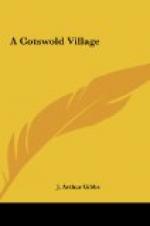“Ah, happy hills!
ah, pleasing shade!
Ah, fields,
beloved in vain!
Where once my careless
childhood strayed,
A stranger
yet to pain:
I feel the gales that
from ye blow
A momentary bliss bestow;
As waving fresh their
gladsome wing
My weary soul they seem
to soothe,
And redolent of joy
and youth,
To breathe a second
spring.”
But soon we are flashing past Reading, where Sutton’s nursery gardens are bright with scarlet and gold, and blue and white; every flower that can be made to grow in our climate grows there, we may be sure. But there is no need of garden flowers now, when the fields and hedges, even the railway banks, are painted with the lovely blue of wild geraniums and harebells, the gold of birdsfoot trefoil and Saint John’s wort, and the white and pink of convolvulus or bindweed. We are passing through some of the richest scenery in the Thames valley. There, on the right, is Mapledurham, a grand mediaeval building, surrounded by such a wealth of stately trees as you will see nowhere else. The Thames runs practically through the grounds. What a glorious carpet of gold is spread over these meadows when the buttercups are in full bloom! Now comes Pangbourne, with its lovely weir, where the big Thames trout love to lie. Pangbourne used to be one of the prettiest villages on the river; but its popularity has spoilt it.
As we pass onwards, many other country houses—Purley, Basildon, and Hardwick—with their parks and clustering cottages, add their charm to the view. There are the beautiful woods of Streatley: hanging copses clothe the sides of the hills, and pretty villages nestle amid the trees. But soon the scene changes: the glorious valley Father Thames has scooped out for himself is left behind; we are crossing the chalk uplands. On all sides are vast stretches of unfenced arable land, though here and there a tiny village with its square-towered Norman church peeps out from an oasis of green fields and stately elm trees. On the right the Chiltern Hills are seen in the background, and Wittenham Clump stands forth—a conspicuous object for miles. The country round Didcot reminds one very much of the north of France: between Calais and Paris one notices the same chalk soil, the same flat arable fields, and the same old-fashioned farmhouses and gabled cottages.
But now we have entered the grand old Berkshire vale. “Fields and hedges, hedges and fields; peace and plenty, plenty and peace. I should like to take a foreigner down the vale of Berkshire in the end of May, and ask him what he thought of old England.” Thus wrote Charles Kingsley forty years ago, when times were better for Berkshire farmers. But the same old fields and the same old hedges still remain—only we do not appreciate them as much as did the author of “Westward Ho!”




